We explore the Paleozoic Era, and discuss its characteristics and divisions. In addition, we describe its climate, flora and fauna.
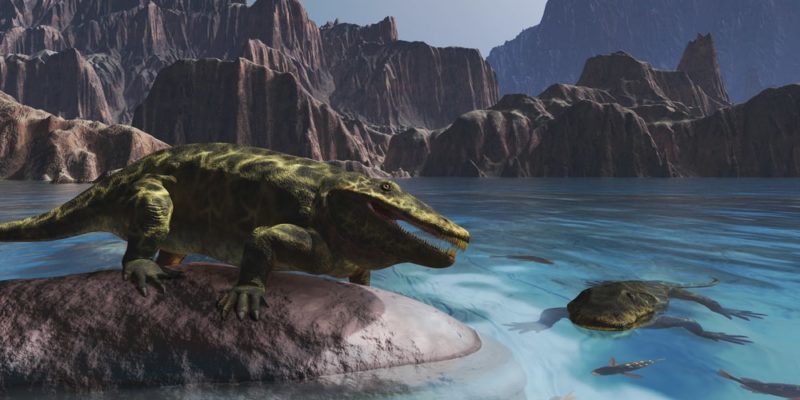
What was the Paleozoic Era?
The Paleozoic Era is the first era of the Phanerozoic Eon, which began 540 million years ago and extends to the present day. Also known as the "age of invertebrates", the Paleozoic began 540 million years ago and ended 248 million years ago with the end of the Permian Period, the last of the era. It spanned about 292 million years.
The Paleozoic Era saw the proliferation of living things, especially in the seas: mollusks, marine arthropods (such as trilobites, crustaceans, calcareous sponges, brachiopods, and echinoderms) and armored fish rose and spread during this span of time.
Nearly all of this great biodiversity of plant and animal life disappeared towards the end of the era as a consequence of the Permian-Triassic mass extinction, a turning point for life at the time.
The term Paleozoic derives from the Greek words palaio (meaning "old") and zoe (meaning "life form", "animal"). Hence, Paleozoic means "ancient life".

- See also: Mesozoic Era
Division of the Paleozoic Era
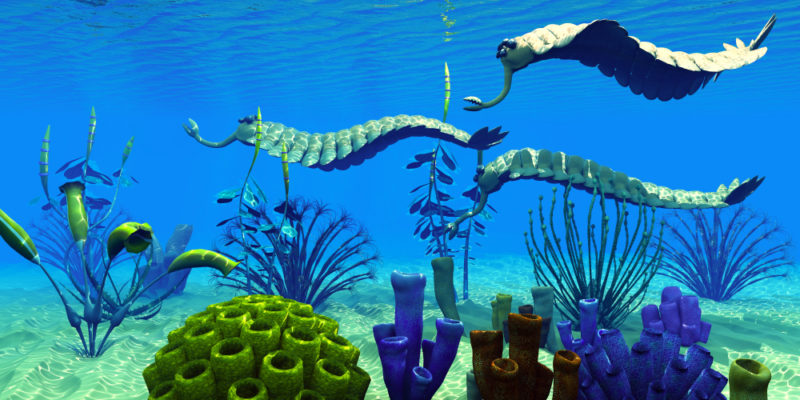
The Paleozoic Era is traditionally divided into six geologic periods:
- Cambrian Period. The oldest of all, it began with the era 540 million years ago and ended 490 million years ago.
- Ordovician Period. It began 490 million years ago and ended 443 million years ago.
- Silurian Period. It began 443 million years ago and ended 417 million years ago.
- Devonian Period. It began 417 million years ago and ended 354 million years ago.
- Carboniferous Period. It began 354 million years ago and ended 290 million years ago.
- Permian Period. The last period of the era, it began 290 million years ago and ended 248 million years ago.
Geology of the Paleozoic Era
From a geological perspective, the Earth in the Paleozoic looked dramatically different from what it looks today. The era began with the breakup of the supercontinent of Pannotia in the wake of the Precambrian. This rifting led to the formation of the continents of Laurentia, Baltica, Siberia, Kazakhstan, and Gondwana.
Following the glacial period known as the "Cambrian glaciation", sea level rose, causing many landmasses to be flooded. This led to the formation of inland seas covering large areas.
Throughout the Paleozoic, the continents drifted and gradually came together. Towards the end of the era during the Permian Period, the continents assembled to form the supercontinent of Pangea, a single landmass at the center of the Earth, surrounded by a vast ocean called Panthalassa.
Climate of the Paleozoic Era
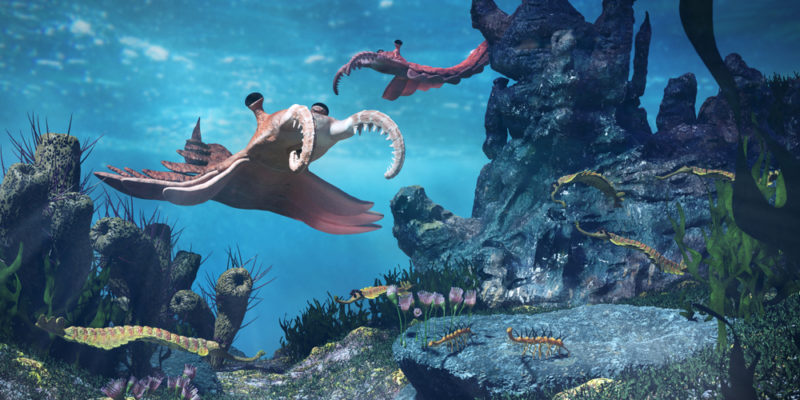
The Paleozoic started after the major Cryogenian glaciation in the late Precambrian. During the early part of the Paleozoic, the era was characterized by a relatively warm and humid climate. Higher global temperatures enabled the expansion of oceans and the diversification of marine life into primitive multicellular forms.
As the Ordovician Period evolved, a gradual cooling of the planet's temperature took place, resulting in the expansion of glaciers in the polar regions.
One of the most important events in the Paleozoic climate occurred during the Devonian Period. About 370 million years ago, the Earth experienced an extensive glaciation known as the "Late Devonian glaciation". During this event, ice masses advanced, and global temperatures dropped sharply.
With the beginning of the Carboniferous Period, climatic conditions changed, and temperatures rose once again. The Carboniferous was characterized by subtropical climatic conditions, high temperatures, and elevated humidity. This climate favored the formation of vast expanses of forest and jungle, which later gave rise to important coal deposits.
The Paleozoic ended with one of the most devastating extinctions in Earth's history, which marked the transition to the Mesozoic Era. The Permian-Triassic mass extinction, about 252 million years ago, resulted in the disappearance of nearly all living organisms.
One hypothesis holds that temperature plummeted due to massive volcanic activity. The ash from volcanoes would have prevented sunlight from passing through, causing lack of light and heat. This would have been one of the causes of this mass extinction.
Flora of the Paleozoic Era

In the early Paleozoic, life was confined to the seas. The dominant flora consisted of phytoplankton, algae, sponges, and photosynthetic bacteria. However, over the course of the era, life greatly diversified, and during the Silurian Period the first plants appeared. They did not possess the vascular capabilities of modern plants to draw water and nutrients from the soil and distribute them through their branches, so they are believed to have been small in size.
During the Devonian Period terrestrial plants adapted to the environment. Ferns, the earliest trees, and shrubs arose, and by the end of the Paleozoic, extensive forests could be found on the continents, especially during the Carboniferous Period. The earliest modern plants (conifers) emerged towards the end of the era.
The Cambrian explosion
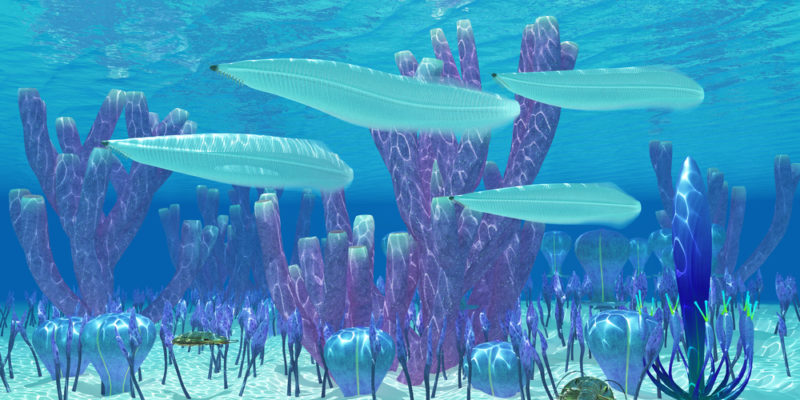
The Cambrian evolutionary radiation, also known as the "Cambrian explosion", was a sudden and major diversification of life that occurred in the Cambrian Period, about 541 million years ago. During this time period, most of the primitive ancestors of current life-forms appeared. These organisms were the earliest forms of complex multicellular life to exist.
The exact causes of the Cambrian explosion are unknown and are still the subject of debate. Various theories are linked to the rise in oxygen levels in the atmosphere, geological change, and ecological competition.
Hydrocarbon formation
The Carboniferous Period witnessed the formation of the large deposits of coal that humans would later exploit as an energy source during the Industrial Revolution.
The origin of these resources is accounted for by the extraordinary spread of plant life during this period. As plants died, the remains accumulated forming layers of plant matter that did not fully decompose. Over time, the pressure and heat resulting from sedimentation transformed these layers into coal. Thus, over millions of years, plant matter gradually turned into coal deposits.
Fauna of the Paleozoic Era
In the early Paleozoic, fauna was limited to a small number of marine multicellular species, collectively known as the "Vendian" or "Ediacaran" fauna. Following the Cambrian explosion, animal life diversified considerably.
In this time period organisms such as trilobites and archaeocyathids originated, as well as life-forms that anticipated the complex species that would evolve later. During the Ordovician Period, marine invertebrates were the most abundant life-form, later followed by fish, which diversified during the Devonian Period.
Fauna first appeared on land in the middle Paleozoic. Initially, it consisted of invertebrates like arthropods, until the end of the Devonian Period when the earliest tetrapods emerged. They had a rather reptilian appearance and extremely diverse forms, and their size ranged from 4 inches to 16 feet (10 cm / 5 m).
A particularly important species during this transition to land was the coelacanth (Coelacanthimorpha), which rose in the Devonian Period and was thought to be extinct until a specimen was caught in 1938 in South Africa. The discovery of this fish was a milestone in biology, as it allowed for the study of fauna from millions of years ago. It is believed that the coelacanth might have used its fins to push itself out of the water, possibly making it one of the first species from the period to live outside of the oceans.
The Permian-Triassic mass extinction
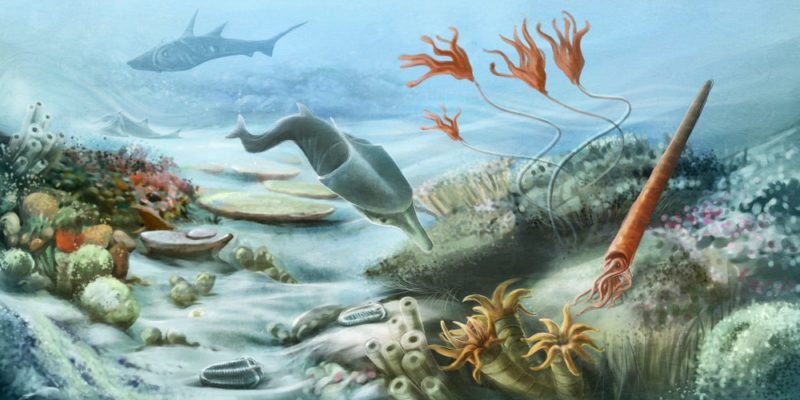
The last event of the Paleozoic Era is known as the "Permian-Triassic mass extinction", the most severe extinction event in the history of planet Earth. Most life-forms disappeared in the boundary with the Mesozoic Era. As a result, new life-forms were able to take the vacant ecological niches and thrive due to the absence of predators.
While the exact causes of such a devastating mass extinction are unknown, several hypotheses have been proposed:
- Contamination of the atmosphere by emission of gases including sulfur and carbon dioxide from volcanic activity.
- The impact of an asteroid, which could have had catastrophic consequences on the flora and fauna of the time.
- The release of hydrogen sulfide (a powerful toxic agent) in marine waters, due to the proliferation of anaerobic bacteria caused by a decrease in oxygen.
- A dramatic increase in volcanic activity towards the end of the period, which would have been responsible for massive amounts of ash into the atmosphere, darkening the sky, making temperature drop, and decreasing photosynthetic activity. This could have caused an increase in carbon dioxide levels and a decrease in oxygen.
Explore next:
References
- AstroMía. (s.f.). El Paleozoico: Cámbrico, Ordovícico y Silúrico. https://www.astromia.com/
- National Geographic. (2010). Período Carbonífero. https://www.nationalgeographic.es/
- National Geographic. (2022). Período Pérmico. https://www.nationalgeographic.es/
- Sabadell, M. A. (2022). Carbonífero: la época de las plantas y los insectos gigantes. Muy Interesante. https://www.muyinteresante.es/
- Tarbuck, E. y Lutgens, F. (2005). Ciencias de la Tierra. Una introducción a la geología física. Pearson Educación.
Was this information useful to you?
Yes NoThank you for visiting us :)